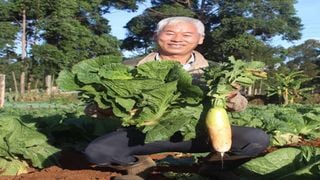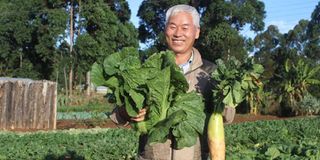
Yohan Kim, a South Korean missionary, displays some of the Asian crops on a farm at AIC Mission College at Kapsoya, Uasin Gishu County.
| Stanley Kimuge | Nation Media GroupSeeds of Gold
Premium
Meet the missionary ‘preaching’ Asian crops farming
What you need to know:
- To grow the crops, the farm first source disease-free soils from the forests.
- Inside one of the greenhouses, seeds are propagated in the nursery trade pots to curb wastage.
A variety of plants dot the expansive Grace Farm at AIC Mission College at Kapsoya on the outskirts of Eldoret town, Uasin Gishu County.
On a cursory look, it is lush and green but this is not your usual farm. Here, the farm specialises in growing Asian crops from Korean strawberry (Maehyang), garlic chives, Korean cabbage, Korean radish, Indian Pak Choi, Italian spinach, leek onions, dragon fruit, Red-leaf lettuce (Lactuca sativa), Korean Perilla leaf vegetable and other herbs.
In 2018, 58-year-old Yohan Kim, a South Korean missionary, travelled to Kenya to preach the gospel but in the process, started the farm that grows Asian foods. They also farm other crops that include net melons and watermelon, fig trees and three varieties of chillies – the mild, hot and sweet.
The theologian noted that he was motivated to venture into Asian vegetables in 2019 due to the growing demand for the produce in the region. Initially, they started on a quarter acre piece of land but have since expanded to four-acres.
“I am passionate about farming because the Bible and agriculture are closely intertwined. This crops are on demand, rich in minerals and highly medicinal,” the farmer tells Seeds of Gold.
Disease-free soils
Inside the four-acre farm, there are four greenhouses. In two of them, it acts as a nursery while in another, they have planted dragon fruits, while in a separate greenhouse, they dry the produce such as chillies on trays.
To grow the crops, they first source disease-free soils from the forests. Inside one of the greenhouses, they propagate the seeds in the nursery trade pots to curb wastage.
They regularly sprinkle with water and after four days, they sprout. It takes two to three weeks where they regularly water the seedlings to be ready for transplanting in several well-arranged seed-beds.
According to Dedan Okisoi, the farm manager, most of the Asian crops take between two and three months to mature. At the farm, they propagate the seeds at different stages to ensure that they have constant supply of the produce in the market.
“Most Asians consume our crops but right now, more Africans are liking these vegetables. We are seeing the demand going up,” says the farm manager.
Most of the produce end up in markets in Eldoret town but hopes to reach new markets such as the Kisumu, Kakamega, Nakuru and neighbouring country, Uganda.
Unique crops
A kilogramme of garlic chives goes for KsSh50 while the Korean cabbages retails for between KShs80 in the market. In a good month, they sell up to 40 to 50 kilogrammes of garlic chives.
“The cabbage can be eaten as salad or cooked. Unlike the local cabbage varieties, one can weigh between one kilogram to five kilos,” says Okisoi.
Today, the missionary is also passionately involved in spreading the gospel of growing these unique crops. The farm serves as a demonstration farm where farmers, especially the young people within the community, are taught modern technologies.

Yohan Kim, a South Korean missionary, displays some of the Asian crops on a farm at AIC Mission College at Kapsoya, Uasin Gishu County.
In the farm, they use overhead irrigation to ensure constant production of the crops all-year round. They source water from three boreholes where they harvest during the rainy season then pump to tanks.
Some of the challenges they face include water scarcity, pests and diseases such as cut-worms, aphids and snails during the rainy season. In the farm, they organically control these pests. For instance, they grind the Tithonia plant, chilies and salt then spray the crops.
Livestock rearing
“We use chemicals as the last option. We want to ensure that our food is safe for the consumers and protect our environment,” observes Okisoi, adding that at a given time, the farm employs between five to 20 workers depending on the volume of work.
They also practice soil rotation to reduce soil-borne diseases. For instance, they plant and replace crop from different family.
“The weather is also a challenge because some of the crops of the crops like yellow melon and fruits thrive well in the area. When we started, they didn’t grow well. When it is hot sometimes, the Korean vegetables rot because it’s roots cannot access water and minerals such as boron and calcium,” says Kim.
He notes that their future plans are to expand the acreage under the Asian crops and introduce livestock rearing as well as set up a unit to provide short-courses on modern ways of crop and livestock production.
Carol Mutua, Crops, Horticulture lecturer at Egerton University observes that Asian crops such as garlic chives, Korean strawberries and Korean cabbages are locally susceptible to pests and diseases such as thrips, aphids and cut worms.
Common diseases
The expert says that cabbage aphids suck sap in Korean cabbages and Indian Pak Choi, causing curling of leaves and transits viruses that one can control using insecticides or biologically using the lady bird beetle.
She notes that diamond back moth is another pest, a caterpillar that is injurious. It is the most important pest of brassicas worldwide. It feeds on leaf lamina from the underside causing windowing effect.
“One can control this pest biologically using – Bacillus thuringiensis or intercropping with strong smelling plants like onions, use of a trap crop like mustard and biopesticides such as neem or pyrethrins which are effective and environment friendly,” advises the scientist.
Other common diseases that affect the Korean cabbages that a farmer must contend include club root, black leg and damping off.
“Club Root fungal disease that appears as a swelling of the root (appears enlarged) causing wilting. It is favoured by poor drainage and pH < 5.5. As control measure, one must ensure proper drainage, maintaining pH at > 7 and soil sterilisation,” she adds.





